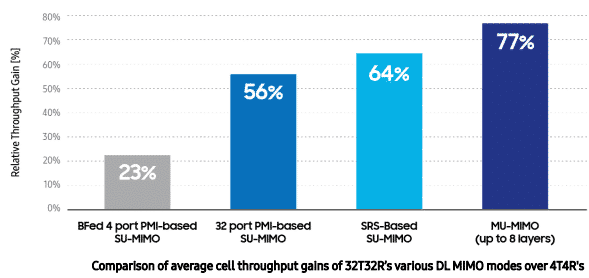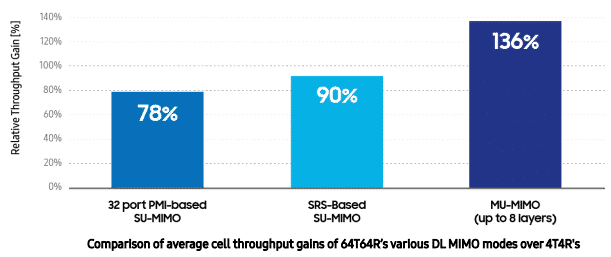Below the performance comparison of massive MIMO radio with a legacy 4T4R sector antenna several interesting points are observed from the results:
- DL SU-MIMO with a 32T32R massive MIMO radio system shows a gain from 23% to 64% in terms of average cell throughput compared with 4T4R legacy antenna system according to different CSI acquisition and beamforming methods.
- SU-MIMO using fourport beamformed CSI-RS has a relatively lowergain than the other MIMO schemes, but still, 23% gain over 4T4R is expected.

- DL SU-MIMO modes with a 64T64R massive MIMO system are expected to increase gains over the average throughput of 4T4R legacy antenna system by a range of 78% to 90%. The user-specific beam gain of the 64T64R massive MIMO radio is enhanced by 3 dB over that of the 32T32R’s. Such gain results in about 22% additional throughput gain for the 64T64R massive MIMO radio of PMI-based SU-MIMO mode over the 32T32R massive MIMO radio of PMI-based SU-MIMO, and 26% gain for the 64T64R massive MIMO radio of SRS-based SU-MIMO mode over the 32T32R massive MIMO radio of SRS-based SU-MIMO.
- Since the standard only defines up to 32 port codebooks, applying PMI-based SU-MIMO with 64T64R massive MIMO radios requires a procedure that decimates 64 physical antenna ports into 32 ports. Here, it is assumed that 32 port (user-specifically) beamformed CSI-RS is used. On the contrary, for SRS-based SUMIMO, the base station is able to estimate SRS responses at 64 receive antenna ports and calculate the corresponding user-specific beam of 64 transmit ports without any standard limitation.

- The maximum numbers of DL MU-MIMO layers are assumed to be limited to eight layers for the 32T32R massive MIMO radio and 16 layers for the 64T64R massive MIMO radio in order to guarantee the minimum beam gain. The irrelative gains are 77% and 136%, which are higher than those of other SU-MIMO schemes.
The throughput gain of 16 layer MU-MIMO by 64T64R massive MIMO radio has nearly twice the throughput gain of the eight layer MU-MIMO by 32T32R massive MIMO radio. The gain is based on the assumption of heavy user traffic model (full buffer) and user distribution for good orthogonality between user radio channels. The value can be interpreted as an expected peak capacity of the cell, but it does not necessarily mean there will be an increase of data volume in commercial field.
Benefit from Massive discount on our 5G Training with 5WorldPro.com
Start your 5G journey and obtain 5G certification
contact us: [email protected]


